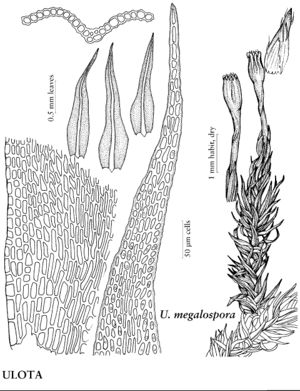Ulota megalospora
Bot. Centralbl. 44: 389. 1890.
Plants 0.5–1.5 cm. Stems both creeping and erect. Stem-leaves curved, erect-appressed, slightly twisted and ± crisped when dry, linear-lanceolate, 1–2.2 mm; base ovate; margins plane; apex filiform-acuminate; basal laminal cells elongate to elongate-elliptic; distal cells 6–10 µm, sometimes smooth, or papillae conic, small. Specialized asexual reproduction absent. Sexual condition autoicous; perichaetial leaves not differentiated from stem-leaves. Seta 1.5–4 mm. Capsule pyriform, short-oblong to oblong-cylindric when old, 0.6–2.2 mm, slightly 8-ribbed 1/3–1/2 length, mouth wide but constricted below mouth or evenly tapering to seta from mouth; stomata near mid capsule; peristome double; exostome teeth reflexed, papillose, often reticulate at apex; endostome segments 8, smooth. Calyptra conic, sparsely hairy. Spores 35–60 µm.
Habitat: Branches and trunks of trees, coastal temperate rainforests
Elevation: low elevations
Distribution

B.C., Alaska, Idaho, Oreg., Wash.
Discussion
Ulota megalospora is distributed along the West Coast from northern California north to northernmost coastal British Columbia, and known inland only in northern Idaho. This species is easily differentiated by the creeping stems with many erect branches (much like Macromitrium) and leaves with filiform apices. Also, the stomata of U. megalospora are located mid capsule, not at the capsule base as in other species of the genus. The spores are large (greater than 35 µm). It is possible that the Japanese species, U. reptans, also occurs in North America; this species resembles U. megalospora in growth form but with smaller spores and non-filiform leaf apices.
Selected References
None.
Lower Taxa
"/3" is not declared as a valid unit of measurement for this property. "/2" is not declared as a valid unit of measurement for this property."wide" is not a number.
